|
|
Bona Vista

|
|
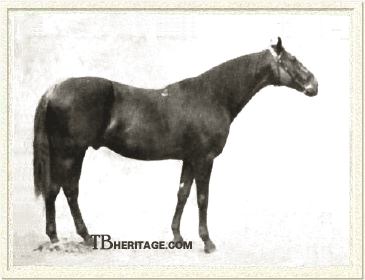 |
|
|
When, at the end of the 1887 English racing season, the Duke of Westminster's unbeaten Triple Crown champion Ormonde was retired from the turf, it was widely expected that the classically-bred son of Derby winner Bend Or and Derby winner Macaroni's daughter Lily Agnes would become a fashionable and very successful stallion. It was a strange twist of fate that Ormonde served only two seasons in Britain before becoming critically ill and leaving literally only a handful of foals to represent him in his native land. By 1889, he had been sold and was about to be shipped for stud duty to Argentina. At the same time, frolicking in a lush field at Mentmore Stud, was a chestnut colt, bred along similar lines, by Bend Or from a Macaroni mare, who would in time, become a classic winner and establish the Bend Or male line as the most dominant one in Thoroughbred breeding. This was Bona Vista.
Bona Vista never won beyond a mile during his turf career. As a stallion, he enjoyed only a brief career in his native land before being exported to Hungary. He excelled as a sire of precocious juveniles, and his grandson, The Tetrarch, was renowned as one of the fastest horses ever to grace the turf. But Bona Vista could get animals capable of the classic distances of ten to twelve furlongs: he sired nine classic winners that won over twelve furlongs, and in England, his son, Cyllene, captured the 2-1/2 mile Ascot Gold Cup, while his daughters produced major stakes and classic winners of ten to twelve furlongs in six countries.
Mentmore Towers, near the little village Mentmore, in Buckinghamshire was the family home of Baron Mayer de Rothschild, born in 1819. He built a magnificent palatial "country house" on his property, completed in 1854. The plans for the house were drawn by Joseph Paxton, famed as the architect of the Crystal Palace, home of the Great Exhibition of 1851.
Baron Mayer developed a great interest in breeding and racing Thoroughbreds, and from the paddocks of Mentmore came classic winners Hippia, Tomato, Tormentor, Kingcraft, and Hannah. The latter was named for Baron Mayer's only child, his daughter. When Baron Mayer died in 1874, Hannah inherited Mentmore. She and her mother continued the family racing tradition, purchasing Macaroni for 7,100 guineas in 1875.
A foal of 1860, Macaroni was a product of the Duke of Westminster's Eaton Stud and was by Sweetmeat from a half-sister to Touchstone. As a three-year-old, Macaroni was unbeaten, his victories including the Two Thousand Guineas, Derby, and Doncaster Cup. Macaroni was to prove an exceptional sire of fillies; three of his daughters won the Epsom Oaks, and another, Lily Agnes, produced Ormonde. The year he was purchased for stud duty at Mentmore, his daughter Spinaway captured the One Thousand Guineas and Oaks. Macaroni proved to have an affinity for the blood of Bend Or. His daughters, when mated to that stallion, produced, many high-class winners and superior broodmare daughters, such as Ornament, dam of the four-time classic-winning filly Sceptre. Then there was his daughter Vista, one of the first horses bred at Mentmore after Hannah de Rothschild's marriage in 1878 to Archibald Philip Primrose, fifth Earl of Rosebery.
Before his marriage, Lord Rosebery had established a stud called The Durdans, and after the wedding, he also took charge of the operations of the Mentmore Stud. Vista, one of the first products of the combined studs, was foaled in 1879. Vista's dam, Verdure, by Mentmore stallion King Tom, was a victress in the Newmarket Oaks. Her best offspring was Vista, who was not a filly of classic aspirations, but a durable, honest stakes winner that could go a distance. Vista's victories included the Prince of Wales's Nursery Stakes and the Great Northern and Great Metropolitan Handicaps.
At stud, Vista produced seven foals, four fillies and three colts. The fillies proved useless for the most part, for none of them won a race, and only Floridiana, by Bend Or, had any significance at stud, being the second dam of Oesterreichisches Derby winner Dealer. Vista's three sons were, in addition to Bona Vista, the Barcaldine colt Sir Visto, winner of the Derby and St. Leger in 1895, and the Donovan colt Velasquez, winner of several important races, including the Eclipse Stakes and Champion Stakes and second to Triple Crown championGaltee More in both the Two Thousand Guineas and Derby in 1897. Bona Vista, the eldest of this trio, was sold as a yearling. Given the fact he turned out to be a colt of classic quality, Lord Rosebery did not repeat the same mistake, holding on to Sir Visto and Velasquez.
Bona Vista was included in a draft of Lord Rosebery's yearlings sold at Newmarket in 1890. Lord Rosebery had a reserve of 1200 guineas placed on his chestnut Bend Or--Vista colt. He fancied the colt very much, and when he was knocked down to Charles Day Rose for 1250 guineas, Rosebery suffered pangs of regret at letting the youngster go.
Bona Vista on the Turf
Bona Vista was sent to the yard of trainer William Jarvis. He showed himself to have considerable talent and precocity by winning the Woodcote Stakes at Epsom by half a length over the well-regarded Pilgrim's Progress, a son of Isonomy and the dual-classic winning mare Pilgrimage. Pilgrim's Progress gained some matter of revenge by finishing ahead of Bona Vista in the New Stakes at Ascot, when he finished second to the good Ormonde colt Goldfinch as Bona Vista crossed the finish post third. Bona Vista's third and last start as a juvenile came in the Chesterfield Stakes at Newmarket in July. Again he was third, this time to two fillies, daughters of St. Simon and Galopin, respectively, La Fleche and Lady Hermit.
Bona Vista was not seen on a racecourse again until April, 1892, when he captured the one mile Newmarket Biennial under 131 pounds as a preparatory for the Two Thousand Guineas. In the classic, Bona Vista ran the best race of his short career, earning a smartly run victory by a length and a half from the Galopin colt St. Angelo. Thereafter, Bona Vista was only a shadow of his former self. He was unplaced to Sir Hugo in the Derby and survived a stewards' inquiry that he had caused interference to the fourth place finisher St. Angelo, the same colt he had easily defeated only weeks previously in the Guineas. At Ascot on June 14th, Bona Vista ran a lackluster race to again finish unplaced in the Prince of Wales's Stakes. Bona Vista was retired from the turf after his effort at Ascot, and the racing news for the rest of the season was filled with the heroics of the great filly La Fleche and the courageous Orme. The former racked up victories in the One Thousand Guineas, Oaks, and St. Leger, while Orme returned from the controversial near-fatal illness which kept him from the classics to score a gallant victory over Orvieto in the Eclipse Stakes and then go on to win several other races at Goodwood and Newmarket that season, including the Sussex Stakes at Goodwood and the Limekiln and Champion Stakes.
Bona Vista in the Stud
Mr. Rose owned Hardwicke Stud near Pangbourne, in Berkshire. It was there Bona Vista was installed at stud, his services commanding a fee of merely 25 guineas, a bargain for a son of Bend Or who had won a classic.
From his first crop came CYLLENE. Bred by Mr. Rose from his Isonomy mare Arcadia, the little chestnut son of Bona Vista was lightly-regarded at first. His small stature, in addition to the fact his dam had previously produced nothing of merit, led his breeder to decide against nominating the colt to the classic races.
|
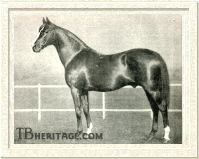
Cyllene
| |
Rose had cause to regret this when CYLLENE, whom he kept to race in his colors, emerged as one of the best two-year-olds seen out in 1897. He captured the Sefton Park Plate, Worth Stakes, National Breeders Produce Stakes, and finished a courageous second by less than a length in the Imperial Produce Stakes at Kempton Park under a staggering 136 pounds. At three, CYLLENE made only three starts, placing third in his debut and then taking the Newmarket Stakes over Jeddah, who shortly thereafter captured the Derby. In the Jockey Club Stakes at Newmarket at the end of September, CYLLENE won over a field which included classic winners Chelandry and Airs and Graces and classics-placed Velasquez. A win in the Sandown Foal Stakes closed out CYLLENE'S three-year-old season. At four, his major triumph came in the Ascot Gold Cup. |
CYLLENE was retired to Rose's Hardwicke Stud, and despite his wonderful record on the turf, he started out at a fee of 150 guineas. In his second crop came Cicero, winner of the Epsom Derby for his breeder, Lord Rosebery, a fitting turnabout for the man who had let Cicero's grandsire go through the sale ring as a yearling. Despite siring a Derby winner, CYLLENE was sold in early 1908 to stand stud in Argentina, at the famed Ojo de Agua Stud. From his crops left behind in England came three more Derby winners -- Minoru, Lemberg, and the filly Tagalie. His most important son from a breeding standpoint was Polymelus, a member of the same foal crop as Cicero. Not blessed with the same level of talent as Cicero, Polymelus went on to become England's leading sire five times and sire five classic winners. In turn, his son Phalaris, also a leading sire, begot influential sons Fairway, Pharamond II, and Pharos, the latter the sire of Nearco.
Important producing daughters of CYLLENE included Maid of the Mist, Bellavista, Mistrella, and Bertha. This quartet of daughters was responsible for classic winners Captain Cuttle, Sunny Jane, Craig an Eran, Beam, and Ix, the latter a classic winner in Argentina.
Bona Vista's English-bred son, BONAROSA (1897, from Rose Madder by Rosebery), won Epsom's Woodcote Stakes as a juvenile, and at age three took Ascot's eight furlong St. James's Palace Stakes.
The best race filly Bona Vista sired in England was SANTA CASA, a bay daughter of the Galliard mare Lorette. Her second dam was a full sister to the first Duke of Westminster's Two Thousand Guineas and Derby heroine Shotover. With such a pedigree, SANTA CASA went to the track with high expectations. She was to prove a useful stakes winner. Her wins came in the Fitzwilliam Stakes, Triennial Stakes, the City of London Breeders Foal Plate, and the Rutland Stakes. She did not make an impact immediately at stud, but in time she became the matriarch of a family which over the generations saw many top class members emerge. Her direct female descendants included the popular steeplechaser Devon Loch, Irish Grand National winner Revelry, American stakes winners Peace Harbor and Sun Alexandria, Prix Ganay winner Norseman, and Mahan and Worden, half-brothers who each captured major stakes in France and North America, both notching victories in the Prix du Conseil Municipal and Washington D.C. International. Jacutinga, a Group I winner in Brazil traced in the direct female line to Santa Casa, as did Prix du Jockey Club champion and major sire Le Fabuleux.
From his brief service in England, Bona Vista got four fillies who became broodmares of varying importance. BREVIARY, out of Penitent, by Hermit, was foaled in 1895. She was not noteworthy as a turf performer, but she foaled a good colt by St. Simon in Primer, second to the filly Signorinetta in the Derby of 1908 and winner of the Hardwicke Stakes at Ascot the following season. Bona Vista’s daughter, MADDALENA, also foaled in 1895, was like BREVIARY, out of a mare by Hermit. She made a name for herself as a producer in France, where her daughter Princess Margaret, foaled in 1905 to the cover of Raconteur, proved a good filly on the French turf, taking the Prix du Petit Couvert as a two-year-old in 1907 and the Prix de la Foret the next season at three. Princess Margaret, in her turn, became an important producer in Germany, her daughter Perle winning the Deutscher Stutenpreis and placing in the Preis der Diana and daughter Pontresina capturing the Deutsches Derby in 1915.
LADY CHANCELLOR (1895), out of the Ossian daughter Lady Cecil, produced the English classic winner Challacombe (1902, by St. Serf), winner of the Doncaster St. Leger, and several daughters that bred on, including Lady Challacombe (1901). Lady Challcombe, a modest winner of three races in twenty starts, was sent to Italy, where she produced Kibwesi (1913, by Galeazzo), who won twelve of his thirteen starts -- including the Premio Chiusura as a juvenile and the Premio Ambrosiano, Premio Sempione, and St. Leger Italiano at age three -- and placed second once. Kibwesi, who could not run in the Italian Derby because he was injured, and could not race abroad, due to the war, became a very successful sire of classic winners in Italy, and an influence for stamina.
|
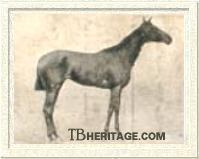
Rose Tree
| |
ROSE TREE, foaled in 1896, was a bay filly from the Minting mare Fanny Relph. Rose Tree's dam traced back in the tail-female line to the Lanercost daughter Ellerdale, dam of Derby winner Ellington and Oaks victress Summerside. However, the family had been quiescent for nearly forty years when ROSE TREE was foaled. ROSE TREE herself never had any classic aspirations, this filly being described as a minor stakes winner at best. She did win the Tyro Stakes, the Glasgow Nursery Plate, the Health Stakes, the Wokingham Stakes, and the Bretby Handicap. Eventually, she was claimed by American horseman Ed Corrigan for £200, and exported to the United States.
|
At the age of fourteen, ROSE TREE was purchased by the Clay brothers of Runnymede Farm near Paris, Kentucky. By this time, she was blind. The Clay brothers, so a popular tale goes, had the notion of breeding her to Star Shoot, standing at John Madden's Hamburg Place near Lexington. However, Star Shoot was also blind, and the idea was abandoned. The Runnymede teaser was a horse called Knight Errant, by Trenton. The tale continues that Knight Errant jumped his paddock fence to mate with ROSE TREE. Some versions of the tale have it the other way round. Either way, the resultant foal was Roamer, a bay colt born in 1911. With a farm teaser as a sire and a blind dam who had produced nothing of note, it was not surprising that Roamer was gelded.
Over the next six seasons, Roamer proved himself to be one of the most dominant runners of the American turf. By the time he was retired at the end of the 1918 season, when he was seven, Roamer had started a grand total of 98 times, for 39 victories, 24 of which were in stakes. He won stakes in each season he raced, and his resume boasted scores, in addition to the Saratoga Special, in the Carter Handicap, Brooklyn Derby, Travers Stakes, Huron Handicap, Merchants' and Citizens' Handicap, Saratoga Cup, Havre de Grace Handicap, Empire City Handicap, two editions of the Queens County Handicap and three editions of the Saratoga Handicap. At the age of seven, on August 21, 1918 at Saratoga, Roamer went against time to try and break the 1:35 barrier for a mile. The previous record had been 1:35 1/4, set by Salvator in 1890. Roamer successfully negotiated a mile in 1:34 4/5. He enjoyed only a brief retirement, as on December 31, 1920, his owner, Andrew Miller died suddenly of a heart attack. Only hours later, Roamer slipped on ice in his paddock, broke a leg and was humanely destroyed. Roamer, the grandson of Bona Vista, was inducted into the National Museum of Racing Hall of Fame in 1981.
|
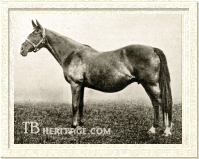
Vahren
| |
The most famous of Bona Vista's producing daughters was undoubtedly VAHREN, born in 1897. A stylish chestnut, she was the fourth foal out of her dam, the unraced Castania by Hagioscope. Her female family was very strong, boasting the likes of English classic winners Cremorne and Briar-root. As a yearling, VAHREN was purchased for merely sixty guineas by Taylor Sharpe, and he made a quick profit by sending her to the Newmarket sale in October, where she was purchased for 240 guineas by John Osborne, a trainer acting on behalf of his client, Oscar W. Rayner, who was determined to buy the filly as a future broodmare prospect.
|
Sent to Osborne's yard near Middleham in North Yorkshire, VAHREN ran but once as two and was unplaced. She won twice in seven starts at three, winning once at Pontefract and once at Manchester. In four starts at four, she won once at Pontefract and was unplaced three times. Each of the races she won carried a purse of only £100 and she never raced outside the north of England. But it was no matter to her owner, for she had always been intended for a broodmare.
VAHREN was first bred to St. Frusqin, but she lost the foal. Rayner tried to cut his losses, and entered her at a Newmarket sale in 1904. When she did not sell, he was prepared to take her home when he accepted an offer of £200 from Irish breeder Edward Kennedy, who sent her to his Straffan Station Stud in County Kildare, Ireland.
After foaling dead twins in 1905 and 1906 and coming up barren in 1907, VAHREN finally justified Kennedy's decision to purchase her. In 1908 came a filly by Symington named Nicola, renowned on the track for her speed. In 1909 came a filly by John O'Gaunt. Purchased by Russian Prince Lubormirski for £650 at the Doncaster yearling sale, the filly, later named Coupe d' Or, captured the Russian Oaks at three. In 1910 came a full brother to Nicola, the colt Coligny, a good stayer on the racecourse. In 1911 she dropped The Tetrach, by Kennedy's imported stallion, Roi Herode. He was purchased as a yearling for 1300 guineas by Irish trainer Atty Persse, who passed him on to his cousin, Major Dermot McCalmont.
As a two-year-old, The Tetrarch swept all before him, but an injury to his right front fetlock suffered during exercise, eventually forced his retirement to Ballylinch Stud, County Kilkenny, which was founded by Major McCalmont expressly for his champion. Despite being a reluctant breeder who sired but 130 foals during his entire stud career (he died in 1935 and had been sterile for some years before that), The Tetrarch was astonishingly successful. He was champion sire in Britain 1919. He sired three winners of the 1-3/4 mile St. Leger in Caligula, Polemarch, and Salmon-Trout. A full sister to Caligula, the gray filly Snow Maiden, captured the Irish Oaks over 1-1/2 miles at The Curragh. Speed was abundant in the majority of The Tetrarch's offspring, with such brilliant representatives as Tetratema, The Satrap, Stefan the Great, and, of course, his remarkable daughter, Mumtaz Mahal.
Sold to Hungary
In 1897, Prince Louis Esterhazy purchased Bona Vista from Rose for 15,000 guineas and the young stallion was exported to the Kisber Stud in Hungary, where he remained for the rest of his life. His loss did not seem to be much lamented at Hardwicke, for his place was soon filled by his son CYLLENE. British breeders in general, through, may have come to lament it when it became apparent that, given a decent chance at stud in Hungary, Bona Vista became an extraordinary sire.
Bona Vista led the Hungarian sire list five times, from 1902-1905 and again in 1908. He sired five winners of the Nemzeti dij (Hungarian Two Thousand Guineas), one winner of the Szent Laszlo dij (one of Hungary's premier two-year-old races), one winner of the Magyar St. Leger, three winners of the Magyar Kanca dij (Hungarian Oaks), two winners of the Austria Preis, two winners of the Oesterreichisches Derby, and three winners of the Oesterreichisches Stutenpreis (Austrian Oaks). Sadly, with the devastation of World War I and the break-up of the Austro-Hungarian Empire, Thoroughbred breeding was to suffer in Hungary for many years. Several of Bona Vista's offspring had limited stud opportunities, or even none at all. He is best remembered for what his colts and fillies did on the racecourses of eastern Europe than for what they accomplished in the breeding shed. Bona Vista's last crop of foals came to the races on the eve of World War I.
|
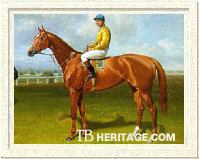
Patience
| |
Bona Vista's most famous offspring from his years in Hungary was undoubtedly PATIENCE, though the filly herself was foaled in Austria in 1902. Her dam was the Galopin mare Podagra, whose dam was a full sister to leading Argentinean sire Gay Hermit and a half-sister to Derby winner Merry Hampton. At two, PATIENCE took the Szent Laszlo dij, and at three, was one of the best performers on the European continent, her victories including the Magyar Kanca dij, Oesterreichisches Derby, Oesterreichisches Stutenpreis, Austria Preis, Deutsches Derby, and the Milleniumi dij. During her short career she was the unbeaten winner of nine races.
|
Like many great racemares, PATIENCE never produced anything that could compare to herself, but she established the "P" family in eastern europe through two daughters, which included winners of the Austria Preis, the Oesterreichisches Derby, and in Hungary, the Magyar Derby winner Notas Kapitany (1966).
The colt BEREGVÖLGY and the filly VIGLANY, both foaled in 1900, were closely related. VIGLANY was out of the great Hungarian mare Kincsem's daughter Budagyöngye (by Buccaneer), while BEREGVÖLGY was out of Budagyöngye's daughter Fursca. Both had a similarly high level of racing talent. BEREGVÖLGY defeated his elders as a two-year-old in taking the Austria Preis, and at three, added the Oesterreichisches Derby (in a "common canter" by six lengths), the Alagi dij, and the Millenniumi dij over older horses. BEREGVÖLGY, who broke down early, enjoyed some success at stud, and was a broodmare sire of note. His son, Basa (1916, from the Desmond mare Mathilde), won both the Nemzeti dij and the Alagi dig at age three, and was later a stallion in one of Hungary's leading studs, but he failed to produce anything out of the ordinary. BEREGVÖLGY also got Austrian Trial Stakes winner Balaton (1907), Austria-Preis winner Landluft (1909), and Graf Hugo-Henckel winner Hadnagy (1906). The brilliant filly Tiszavirag, winner of the Szent Laszlo dij at two, the Oesterreichisches Stutenpreis and Magyar Derby at three in 1928, and the Magyar Kanca dij at four in 1929 (the latter race being unusual in allowing older fillies to compete) was out of one of his daughters, as was Aurelianus, winner of the Jubilaums Preis.
|
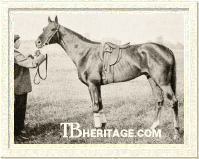
Bono Modo
| |
VIGLANY as a two-year-old took the prestigious Graf-Hugo-Henckel Memorial, and at three captured the Nemzeti dij over colts and the Oesterreichisches Stutenpreis. She produced Sajgo (1920, by Horkay), a winner of the Magyar Kanca dij, and her sister, Nyalka (1917); the latter's descendants included Hungarian classic winners and one branch, sent to Russia, had winners of Moscow's Bolszoj Wsiesojuzny Priz through the late twentieth century, with Gelikon (1971) a recent example.
Another member of Bona Vista's stellar 1900 crop was the chestnut colt BONO MODO, out of Kis-Iblya, by the Buccaneer son Vinea. Plagued by a variety of minor ills, including a bad tooth, his major victory in four wins, from ten starts, came in the Deutsches Derby, and he ran second in the Magyar St. Leger for his owner, Baron G. Springer.
|
The filly LELKEM, foaled from the Craig Millar mare Leleny, came along in 1901 and dead-heated with Mariska for the Magyar Kanca dij in 1904. She had no reported foals. Bona Vista's son BON MARCHE, from Edlweiss by Chamant, won some races in England, and back in Hungary as a stallion got modest winners. Another 1901 foal, BOB ADAMS, from the imported mare Adornment, by Beau Brummel, won the Nemzeti dij at Budapest at age three, as did Menydorgos (1902, from the Hungarian-bred Marilla, by Master Kildare). LANGOLO (1904, out of the imported Santa Monica, by Uncas) also won that race, and in the same year the Austrian Trial Stakes.
SEDIRANDA, a chestnut filly foaled in Austria in 1904, out of See Me by the German horse Stronzian, was Bona Vista's third winner of the Magyar Kanca dij. She bred on through the 1930s. In Bona Vista's 1905 crop came the filly MATKA, a daughter of the Master Kildare mare Marilla. She joined PATIENCE and VIGLANY as the third winner of the Oesterreichisches Stutenpreis for her sire. Another 1905 colt, BONFINI, out of the imported mare Becky Sharpe, by Fitz-Simon, was another winner of the Nemzeti dij for Bona Vista.
|
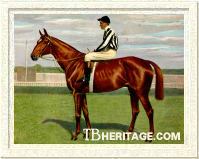
Orient
| |
ORIENT was Bona Vista's next best racing son to emerge, this chestnut colt being foaled at the German state stud at Graditz in 1907. His dam was by the Galopin stallion Fulmen, three-time leading sire in Germany. During his career on the turf, ORIENT accounted for the Graf-Hugo-Henckel at two, and got better as he got older, racking up victories in the Deustsches Derby, Jubilaüms Preis, and Grosser Hansa Preis, in all six wins and three placings in eleven starts in Germany and Austria. He was used as an improvment sire on half-bred mares.
|
Bona Vista's best sire son from his tenure in Hungary arrived in 1909. He was a member of his sire's last foal crop, and was a bay colt out of the Hungarian-bred mare Fancy, by imported English stallion Matchbox. His name was BONY. As a three-year-old, he was victorious in the Alagi dij and the classic Magyar St. Leger. At stud, BONY was near the top of the sire's lists in Hungary (fourth in 1924). He got another winner of the Magyar St. Leger in the filly Add Ide. This filly in her turn became a major stakes producer. She became the dam of Arkasz, yet another winner of the Magyar St. Leger. Arkasz was a successful stallion for the Czech breeding program, becoming the sire of the Czechoslovakian-bred filly Carioca, winner of the Czech One Thouseand Guineas and Czech Oaks., and the colt Povazan, winner of the Czech St. Leger. Add Ide's other important winner was Alagi dij victor Henricus. Some other winners by BONY were the filly Borvirag (1923, Magyar Kanca dij); Brutus (1924, Austria's Graf Hugo-Henckel at age two, and Nemzeti dij and Austria Trial Stakes at age three), and Bona Causa (1916, juvenile winner of the Graf Hugo-Henckel).
Bona Vista's Productive European Daughters
As a sire of broodmares, Bona Vista was exceptional. His English and European daughters produced classic winners and major stakes winners in Hungary, Austria, Russia, Germany, England, and the United States. In Hungary and Austria, mares by Bona Vista produced two winners of the Nemzeti dij (Hungarian Two Thousand Guineas), one winner of the Magyar Derby, two winners of the Magyar Kanca dij (Hungarian Oaks), two winners of the Magyar St. Leger, one winner each of the Oesterreichisches Derby and Stutenpreis. Two of Bona Vista's daughters produced a total of four colts who were either classic winners or major stakes winners.
Bona Vista's daughter INGEBORG (1908), out of a Hungarian-bred daughter of imported Matchbox, was the dam of the brothers Oskar Anton and Ingram. The former, foaled in 1921, was a winner of the Magyar Derby. The latter, a year younger than Oskar Anton, was more speedy and precocious than his elder brother, his victories coming in the Szent Laszlo dij as a two-year-old and in the Nemzeti dij at three. They were both sired by the Hungarian-bred Raeburn stallion Rascal, and sadly, there are no records that either sired anything of note.
Bona Vista's daughter VIGANO (1905), out of the Gaga mare Vig, was the dam of Fuvolas and Vigado. The former was sired by Fantome, a Hungarian-bred grandson of Matchbox, was foaled in 1920. Fuvolas had an incredibly long career on the racecourse, winning the Trial Stakes for three-year-olds at Ebreichsdorf in Austria in 1916 and then capturing the Milleniumi dij for older horses at Budapest in 1920 at the age of seven. Younger by four years and foaled in 1917 was Vigado, by the Austrian stallion King Rob. As a three-year-old, Vigado took the classic Nemzeti dij and the 1 1/4 mile Alagi dij. Again, there is no record of these half-brothers doing anything at stud.
There were two exceptional fillies produced from Bona Vista's European daughters. Bocula, foaled in 1918 from the Bona Vista daughter BOBALKA, was a talented Austrian filly by the French horse Dagor, who had her biggest moment at two when she won the Graf-Hugo-Henckel Memorial at Ebreichsdorf, Austria. At stud, Bocula became the dame Beaupreau. Foaled in 1926, he emulated his dam by capturing the Graf-Hugo-Henckel Memorial at two and then went on to capture the Oesterreichisches Derby and the Milleniumi dij at Budapest at three. Bocula also was the dam of Bakchich, a winner of the Magyar St. Leger. BOBALKA also produced Borgia (1921, a brother to Bocula), winner of the 1924 Alagi dij.
Affenblume, foaled in 1915, was sired by Morpeth, a Hungarian-bred winner of the Oesterreichishes Derby. Affenblume's dam was Bona Vista's daughter ANDORA. A bay filly, Affenblume was the best filly racing in Central Europe in 1918. Several countries in Europe during World War I continued racing on a limited scale to weed out the best individuals for breeding stock purposes, and Austria-Hungary was no different. During the summer of 1918, as the war was entering its final months, Affenblume took home honors as victress in the Oesterreichisches Stutenpreis (Austrian Oaks) and its counterpart in Hungary, the Magyar Kanca dij. She also defeated colts in the Magyar St. Leger. Unfortunately, her produce record was not noteworthy.
Bona Vista's daughter BABATUNDER. foaled in 1899 from the Livingstone mare Thecla, produced the Pardon colt Tunderfi, winner in 1915 of the Alagi dij. Harsona, winner in 1917 of the Magyar St. Leger, was produced from Bona Vista’s daughter NOTA, while Varus, a colt by Gaga out of Bona Vista’s daughter VALUS, was a victor in the 1911 edition of the Graf-Hugo-Henckel Memorial. Floribus, a chestnut colt foaled in 1913 by Falb, was a winner of the Szent Laszlo dij. His dam was the Bona Vista mare SA FLEUR. The Bona Vista mare RUBIN produced Ragyogo, a chestnut filly foaled in 1917 who captured the Jubilaums Presi in Vienna in 1920.
Balbinus (1918) was sired by Horkay and out of the Bona Vista mare BELVEDERE. This colt was an exceptional turf performer in Austria and Hungary in the early 1920s, as he was victorious in the Oesterreichisches Derby and two runnings of the Milleniumi dij. At stud, Balbinus proved a useful sire of broodmares. His daughters produced Zsivany, winner of the Magyar Derby, and Credo, who dead-heated with Rianus for the 1938 edition of the Austria Preis.
BECSALI was a filly by Bona Vista foaled in 1903. She never made a mark as a turf performer, but she produced a very high class filly, Bokros, to the cover of Maxim. Foaled in 1913, Boskros enjoyed a distinguished career on the track during the height of World War I, garnering victories in the Nemzeti dij and the Magyar Kanca dij. When it was her turn to go to stud, she became the dam of Bajtars, whose major victories came in the Alagi dig and the 1925 edition of the Magyar St. Leger, in the latter of which he dead-heated for the victory with Pronto.
Bona Vista died in Hungary at the age of twenty in 1909. Today, he is remembered as the savior of the Bend Or male line, as it is the line through Bona Vista, his son Cyllene, and his grandson Polymelus, that the Thoroughbred has been blessed with the likes of such superior animals as Nearco, Nasrullah, Native Dancer, Bold Ruler, Northern Dancer, Mr. Prospector, Storm Cat, and Sadler's Wells. He is equally notable as the dam's sire of The Tetrarch, whose "flying" daughter Mumtaz Mahal had such an impact on the breed. Yet Bona Vista accomplished much more than establishing an enduring male line. He was the dominant sire in Eastern Europe for some years, despite the extreme limitations put on racing due to The Great War. In the period immediately following the war and into the 1920s, when the breeding and racing industries of continental Europe were attempting to recover from the havoc, daughters of Bona Vista produced some of the finest performers in Eastern and Central Europe.
-- Elizabeth Martiniak |
|
|
|

